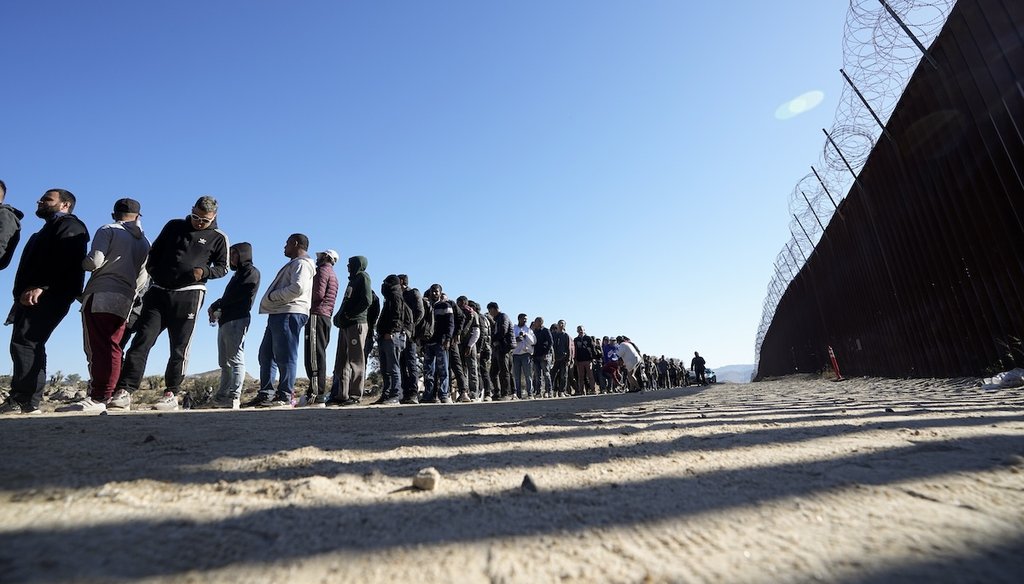Stand up for the facts!
Our only agenda is to publish the truth so you can be an informed participant in democracy.
We need your help.
I would like to contribute

Men line up to receive food from volunteers with Border Kindness after crossing the border with Mexico, Oct. 24, 2023, near Jacumba, Calif. (AP)
If Your Time is short
-
An immigration law provision allows presidents to stop people from entering the U.S. if their entry “would be detrimental to the interests of the United States.”
-
Presidents have used that power to varying success.
-
Courts blocked former President Donald Trump when he invoked that provision to block people from applying for asylum at U.S. borders. But he was eventually successful when he used it to order a travel ban.
-
Our mission: Help you be an informed participant in democracy. Learn more.
President Joe Biden says he has done everything under his authority to try to reduce illegal immigration at the U.S. southern border, and that he’ll be able to do more once Congress passes a new bill. But Republicans disagree.
Biden said Jan. 26 that he’s waiting for a bipartisan bill being negotiated in the Senate to give him more resources and "a new emergency authority to shut down the border when it becomes overwhelmed."
Although the bill’s text remains under wraps, House Speaker Mike Johnson, R-La., says Biden doesn’t need new authority to decrease illegal border crossings. Immigration law and recent Supreme Court precedents already give Biden the authority to secure the border, Johnson said in a Jan. 27 X post.
So, who’s right? Is there more Biden can do? Or is it on Congress to update immigration law, which hasn’t been changed in decades?
In his X post, Johnson quoted section 212(f) of the 1952 Immigration and Nationality Act, which says a president may "suspend the entry" of or impose restrictions "he may deem to be appropriate" if someone’s entry "would be detrimental to the interests of the United States."
Sign up for PolitiFact texts
Johnson has a point that the law gives the president the ability to stop entries. But immigration experts say there’s more to it: That same immigration law also says people can come to U.S. borders and ask for asylum, even if they cross into the U.S. without authorization.
Former President Donald Trump invoked the section of immigration law that Johnson cited when he tried to block people from seeking asylum. But courts stopped his efforts because they were at odds with the immigration law’s asylum section.
Immigration law both restricts and empowers the president
Immigration experts told PolitiFact that although the power vested by section 212(f) is broad, it can’t be used to override other parts of immigration law.
Many administrations have used that authority, to varying success.
Trump invoked the provision more than two dozen times, including to temporarily ban the entry of citizens from mainly Muslim-majority countries. After multiple versions of the ban, the U.S. Supreme Court ultimately allowed Trump to carry out this executive order, saying that the order did not conflict with immigration law.
But Trump failed when he tried using this authority to stop illegal immigration, said Aaron Reichlin-Melnick, policy director at the American Immigration Council, an immigrant-rights advocacy group.
In November 2018, Trump invoked the provision to deny asylum to people who illegally enter the U.S. between ports of entry at the southern border.
A federal judge temporarily blocked this effort, saying Trump’s executive order "irreconcilably conflicts" with immigration law. The law says people must be physically present in the U.S. to seek asylum, regardless of their immigration status or how they entered.
An appeals court sided with the lower court, and the Supreme Court denied Trump’s request to block the appeals court’s ruling.
"No president has the authority to simply shut the border to migrants," Reichlin-Melnick said.
The travel ban legal precedent is different from the illegal immigration situation at the U.S.-Mexico border, said Kathleen Bush-Joseph, a Migration Policy Institute policy analyst.
With the travel ban, the court was dealing with people who were outside the United States. With the southern border, people already on U.S. soil are allowed to seek asylum.
Although 212(f) "does, on its face, give sweeping powers to the President," that power "does not and cannot operate in isolation from our other domestic and international legal obligations," said Lindsay Harris, the International Human Rights Clinic director at the University of San Francisco.
Asylum law provisions are "very much in tension with efforts to ‘shut down’ the border," Harris said.
"Closing the border arguably would violate" domestic and international asylum laws, said Stephen Yale-Loehr, a Cornell University immigration law professor.
Johnson lists other presidential authorities, Biden is already using some of them
Johnson on X listed other actions he said Biden could take to reduce the number of immigrants coming illegally into the country. But Biden is already using several of those mechanisms. The problem is that immigration officials "cannot keep up with demand, which speaks to the need for increased avenues for legal immigration," including family and job sponsorships, Bush-Joseph said.
Johnson’s list included:
-
Expedited removal: Biden is using it to quickly deport people who arrive at the southern border. However, people can be exempt from expedited removal if they can prove a credible fear of returning to their home country and therefore apply for asylum.
-
Mandatory and discretionary detention: Biden is also using this, allowing immigration officials to decide which migrants to detain and release while they await court hearings. There is not enough detention space to detain all migrants who reach the border.
-
Ending "catch and release": The political term refers to immigration authorities stopping and releasing immigrants so they can await their court hearings outside of federal custody. Both Democratic and Republican administrations have followed this practice for decades (including the Trump administration), because there’s limited detention space.
-
Reinstating the "Remain in Mexico" program: The Trump policy required certain asylum seekers to remain in Mexico while awaiting their U.S.-based asylum court hearings. Biden ended the program. Mexico in February 2023 said it would not agree to the program restarting.
Bush-Joseph said that adding more asylum officers and judges could help alleviate the border situation.
Biden said he’s requested congressional funding for 1,300 additional Border Patrol agents, 375 immigration judges and 1,600 asylum officers.
Despite any effort by Congress or the Biden administration to mitigate illegal immigration, there are larger issues that will still drive people to U.S. borders, experts say. Violence in other countries, political persecution and climate change-related displacement are some of those factors, Harris said.
"The U.S. is simply not immune to global increases in forced migration," she said.
RELATED: Ask PolitiFact: What branch of government is ‘really’ responsible for the crisis at the border?
Our Sources
The White House, Statement from President Joe Biden on the bipartisan Senate border security negotiations, Jan. 26, 2024
House Speaker Mike Johnson, R-La., post, Jan. 27, 2024
U.S. Code, §1182. Inadmissible aliens, accessed Feb. 1, 2024
Congressional Research Service, Presidential Actions to Exclude Aliens Under INA § 212(f), May 4, 2020
PolitiFact, Donald Trump ad wrongly describes Nikki Haley’s position on a border wall, travel ban, Jan. 5, 2024
The Washington Post, Trump administration tightens immigration asylum rules as caravans continue to push for U.S. border, Nov. 8, 2018
Cornell Law School, 8 U.S. Code § 1158 - Asylum, accessed Feb. 1, 2024
U.S. Supreme Court, Order in pending case, Dec. 21, 2018
House Speaker Mike Johnson, post, Jan. 30, 2024
U.S. Customs and Border Protection, Custody and Transfer Statistics, accessed Feb. 1, 2024
Congressional Research Service, The Law of Immigration Detention: A Brief Introduction, Sept. 1, 2022
PolitiFact, Chris Christie’s math on apprehensions and detention space is mostly right, but omits context, Oct. 20, 2023
ABC, Mexico rejects any effort to reinstate 'remain in Mexico' policy for asylum-seekers, Feb. 7, 2023
Phone interview, Kathleen Bush-Joseph, policy analyst at the Migration Policy Institute, Jan. 31, 2024
Email exchange, Aaron Reichlin-Melnick, policy director at the American Immigration Council, Jan. 29, 2024
Email exchange, Stephen Yale-Loehr, immigration law professor at Cornell University, Jan. 31. 2024
Email exchange, Lindsay Harris, director at the International Human Rights Clinic at the University of San Francisco, Jan. 31, 2024
Email exchange, Ira Kurzban, immigration lawyer, Jan. 29, 2024
Email exchange, Kevin Johnson, Dean at University of California school of law, Jan. 31, 2024
Email exchange, Speaker Mike Johnson spokesperson, Jan. 29, 2024
Email exchange, White House spokesperson, Feb. 1, 2024








































